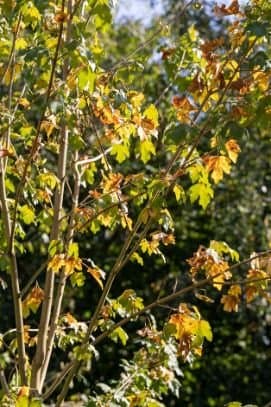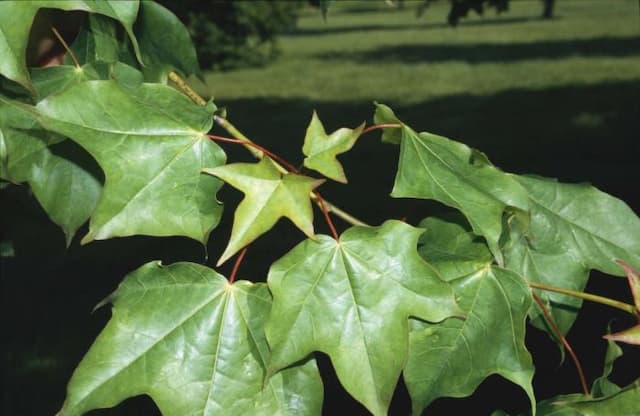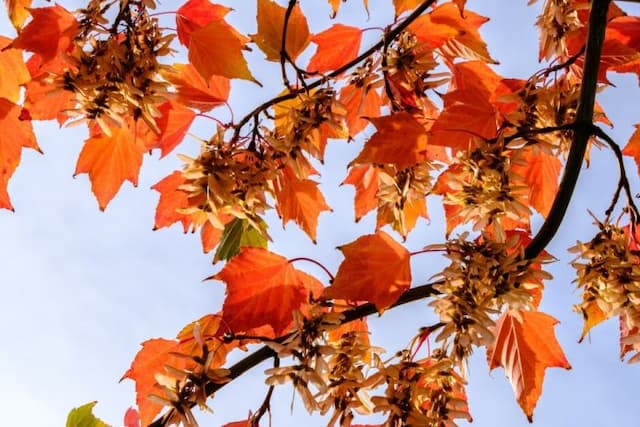Field Maple Acer campestre 'William Caldwell'

ABOUT
The Acer campestre 'William Caldwell', commonly known as the field maple, is a cultivar recognized for its distinctive foliage and attractive form. This variant of field maple typically exhibits a dense canopy of leaves that evolve through the seasons, offering a year-round visual appeal. In spring, the leaves burst forth in a vibrant green hue, their shape is lobed with a somewhat rounded and classic maple appearance. As the seasons transition into autumn, the foliage undergoes a beautiful transformation, presenting a tapestry of yellow and sometimes flushed with subtle reddish or orange tones, providing a warm autumnal display before the leaves ultimately fall. The bark of the field maple 'William Caldwell' adds to its ornamental value. With age, the bark develops a texture that is visually interesting, fortifying the plant's winter silhouette after the leaves have dropped. The branches spread to create an overall balanced shape that is visually pleasing in a variety of settings, including parks and residential landscapes. The flowers of the plant are modest and may go unnoticed against the backdrop of the spring foliage. They typically emerge in small clusters and are of an inconspicuous nature, but they are an important nectar source for pollinators early in the season. Following the flowers, winged seeds known as samaras may be produced, which helicopter away from the parent plant in the breeze, helping to propagate the species. Throughout the year, the field maple 'William Caldwell' is an adaptable and hardy plant that brings both structural and seasonal interest to any planting design, making it a popular choice for gardeners and landscape designers seeking a resilient yet attractive tree.
About this plant
 Names
NamesFamily
Sapindaceae
Synonyms
William Caldwell Hedge Maple, William Caldwell Field Maple
Common names
Acer campestre 'William Caldwell'.
 Toxicity
ToxicityTo humans
The Field Maple is not known to be toxic to humans. There are no common reports of serious poisoning or adverse symptoms from ingesting parts of this plant. As with any plant material, individual allergies or sensitivities could still potentially cause mild irritation or discomfort, but generally, the Field Maple is considered safe and does not pose a significant risk of toxicity to humans when touched or ingested in small amounts.
To pets
The Field Maple is also not known to be toxic to pets. It is generally considered a safe plant with no significant toxic effects reported in domestic animals such as dogs and cats. As with humans, individual animals may have allergies or sensitivities that could cause mild gastrointestinal upset or irritation, but serious toxicity is not expected from the ingestion of parts of this plant by pets.
 Characteristics
CharacteristicsLife cycle
Perennials
Foliage type
Deciduous
Color of leaves
Green
Flower color
Yellow-green
Height
20-35 feet (6-10 meters)
Spread
20-30 feet (6-9 meters)
Plant type
Tree
Hardiness zones
5
Native area
Europe
Benefits
 General Benefits
General Benefits- Aesthetic Appeal: Its attractive, lobed leaves provide visual interest throughout the growing season.
- Shade Providing: This tree offers shade in gardens and parks, which can cool the surrounding area and provide a pleasant outdoor space.
- Habitat for Wildlife: It can serve as a habitat for birds and insects, contributing to local biodiversity.
- Seasonal Interest: Offers a variety of colors throughout the year, including yellow-green flowers in spring and golden yellow leaves in autumn.
- Drought Tolerance: Once established, it is relatively tolerant of drought, making it suitable for drier climates.
- Low Maintenance: Requires minimal pruning and care once established, which can reduce landscaping efforts.
 Medical Properties
Medical PropertiesThis plant is not used for medical purposes.
 Air-purifying Qualities
Air-purifying QualitiesThis plant is not specifically known for air purifying qualities.
 Other Uses
Other Uses- The wood of the Field Maple ('William Caldwell') can be used for making musical instruments like violins and woodwinds, due to its fine grain and ability to carry sound.
- It can serve as a natural dye source; the bark and leaves can be boiled to produce dyes of varying shades for textiles.
- Field Maple wood is often utilized in woodworking and carving, admired for its workability and finish.
- Its durable wood can be used for creating long-lasting furniture pieces.
- Field Maple is sometimes used in veneer production for paneling and cabinetry because of its attractive grain patterns.
- The tree can serve as a host for cultivating certain species of edible mushrooms, such as shiitake, using the logs as a growth medium.
- Smaller branches and twigs can be employed in basket weaving and other types of traditional crafts.
- Field Maple can be implemented in landscape design not only as a visual feature but also for creating windbreaks and hedges for privacy and shelter.
- The tree is occasionally utilized for syrup production, albeit less commonly than its cousin the Sugar Maple.
- It’s utilized in permaculture as part of food forest layers, supporting biodiversity and healthy ecosystems.
Interesting Facts
 Feng Shui
Feng ShuiThe Field Maple is not used in Feng Shui practice.
 Zodiac Sign Compitability
Zodiac Sign CompitabilityThe Field Maple is not used in astrology practice.
 Plant Symbolism
Plant Symbolism- Strength: The Acer campestre, commonly known as the 'Field Maple,' symbolizes strength due to the hardwood it produces, which is used in making durable items and furniture.
- Endurance: Its ability to withstand cold climates and adapt to various soils makes the Field Maple a symbol of endurance and resilience.
- Longevity: With some maple trees living for hundreds of years, the Field Maple is often associated with long life and timelessness.
- Beauty: The attractive foliage of the Field Maple, particularly in the fall when the leaves turn vibrant colors, signifies beauty and the appreciation of visual appeal.
- Wisdom: In some cultures, the maple tree is a symbol of wisdom due to its long lifespan and the observation that the trees grow at their own pace.
 Water
WaterThe Hedge Maple should be watered deeply, ensuring moisture reaches the root zone, about once a week during dry periods. Newly planted trees demand more frequent watering, every few days until they establish. Established trees can typically rely on rainfall, but during extended periods of drought, provide 1 to 1.5 gallons of water every two weeks. Avoid frequent light watering, as it encourages shallow root growth. It's important to adjust the frequency and amount based on weather conditions, soil type, and the tree’s growth phase.
 Light
LightHedge Maple thrives in full sun to partial shade. The optimal spot for this tree is where it receives at least 4 to 6 hours of direct sunlight daily, but it should also perform well under light, dappled shade. Avoid deep shade locations as this can affect the tree's growth and overall health.
 Temperature
TemperatureHedge Maple is hardy and adaptable, preferring the cooler temperatures of USDA Hardiness Zones 5 through 8. It can withstand a maximum temperature of around 86 degrees Fahrenheit and is cold hardy to at least -20 degrees Fahrenheit. The ideal temperature range for vigorous growth is between 60 and 75 degrees Fahrenheit.
 Pruning
PruningPruning the Hedge Maple is done to maintain shape, remove damaged or diseased branches, and encourage healthy growth. The best time for pruning is late winter or early spring before new growth starts. Prune sparingly, focusing on crossing or rubbing branches, and perform structural pruning every three to five years to keep the tree's form aesthetically pleasing and healthy.
 Cleaning
CleaningAs needed
 Soil
SoilFor the Hedge Maple, use well-draining soil with a mix of loam, peat, and sand. The soil pH should be between 6.0 and 7.5 for optimal growth.
 Repotting
RepottingHedge Maples do not need frequent repotting; do it every 3-5 years or when root bound.
 Humidity & Misting
Humidity & MistingThe Hedge Maple tolerates a wide range of humidity levels and does not require specific humidity conditions.
 Suitable locations
Suitable locationsIndoor
For indoor growth, provide bright, indirect light and avoid dry air.
Outdoor
Plant in partial sun; shelter from strong winds.
Hardiness zone
5-8 USDA
 Life cycle
Life cycleAcer campestre 'William Caldwell', commonly known as the William Caldwell Field Maple, begins its life as a seed, which germinates in spring when conditions of moisture and temperature are appropriate. The seedling stage follows, where it develops its first true leaves and roots system, gradually maturing into a young sapling. This sapling period is characterized by significant growth in height and girth, as the plant establishes itself. As it transitions to a mature tree, it develops a thicker trunk, stronger branches, and a broad leaf canopy. The tree reaches its reproductive maturity after several years, producing small yellow-green flowers in spring, which after pollination, develop into characteristic winged fruits called samaras that disperse from the parent tree to propagate new individuals. The William Caldwell Field Maple remains in this mature stage for many decades, potentially living for over a century, and throughout its life, it undergoes seasonal cycles of growth, flowering, and senescence.
 Propogation
PropogationPropogation time
Late winter-early spring
Propogation: The Acer campestre 'William Caldwell', commonly known as the Hedge Maple, is primarily propagated through seed or softwood cuttings. The most popular method of propagation for this plant is through seed, which should be collected in the fall after the samaras, the maple's distinctive winged fruits, have ripened. The seeds require a period of cold stratification to break dormancy, which can be achieved by mixing them with moist sand and storing them in the refrigerator at a temperature of 34 to 41 degrees Fahrenheit (1 to 5 degrees Celsius) for 90-120 days. Once stratified, the seeds can be sown in well-draining soil either in the spring or fall, covering them with a thin layer of soil. Germination can be irregular, taking anywhere from a few weeks to several months, and the young seedlings need to be protected from harsh weather conditions and given time to establish a robust root system before transplanting.









